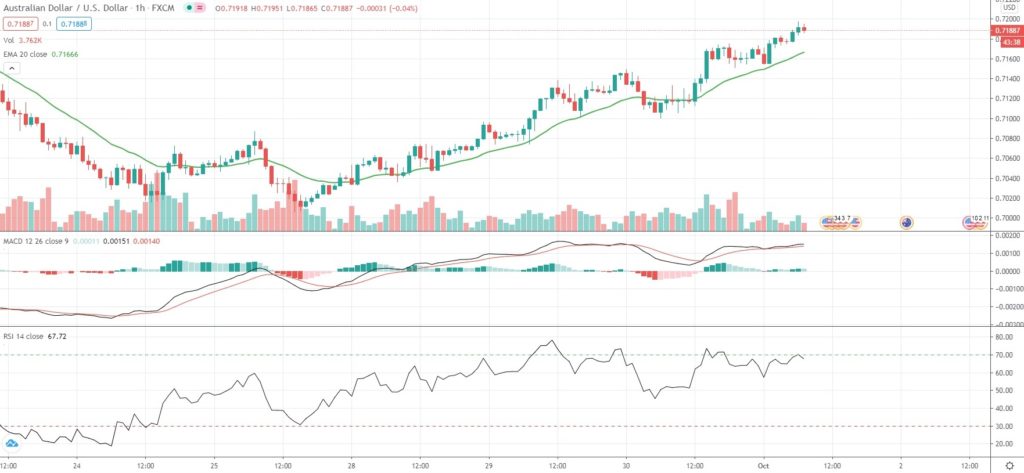AUD/USD extended gains from the previous three trading days on Thursday, while touching a fresh one-week high in early European session, as robust US macro data and optimism over US fiscal stimulus bolstered investor risk sentiment.
US Treasury Secretary Steven Mnuchin said on Wednesday that negotiations with House Speaker Nancy Pelosi had “made a lot of progress” on the coronavirus aid bill, but still, no deal has been reached. On the other hand, Democrats and the White House reached common ground on matters such as direct payments, small business loans and airline aid, Mnuchin told Fox Business News.
However, both sides still have to resolve their differences over state and local government aid, liability protections for businesses, among some other matters.
Meanwhile, the US Dollar eased to a one-week low against a basket of six major peers, as a string of macro data indicated US economic recovery was on track. US private sector companies hired more employees in September than expected, 749,000, while manufacturing activity in Chicago area expanded at the sharpest rate since February 2019 in September.
Additionally, a final GDP estimate showed US economy had shrunk at an annualized rate of 31.4% during the second quarter, which compares with a 31.7% contraction in the second estimate and a 32.9% drop in the preliminary estimate. Yet, it remains the sharpest economic contraction on record.
The Aussie dollar also benefited from upbeat manufacturing data released from China, which suggested factory activity had retained its recovery momentum.
As of 7:11 GMT on Thursday AUD/USD was edging up 0.40% to trade at 0.7189, after earlier touching an intraday high of 0.7197, or a level not seen since September 22nd (0.7235). The major pair retreated 2.91% in September, while snapping a five-month streak of gains.
On today’s economic calendar, a report by the US Labor Department at 12:30 GMT may show the number of people in the country, who filed for unemployment assistance for the first time during the business week ended September 25th, probably eased to 850,000, according to market expectations, from 870,000 in the preceding week.
Also at 12:30 GMT, the US Bureau of Economic Analysis is expected to report on core PCE inflation for August. The Core Personal Consumption Expenditure (PCE) Price Index, which does not include prices of food and energy and represents the Federal Reserve’s preferred measure of inflation, is expected to increase 1.4% year-on-year in August. Annual core PCE inflation was reported at 1.3% in July. Personal income probably decreased 2.4% in August from a month ago, while personal spending probably rose at a monthly rate of 0.8%, according to market expectations.
And a report by the Institute for Supply Management at 14:00 GMT may show activity in US manufacturing industry expanded for a fourth straight month in September. The respective Manufacturing Purchasing Managers’ Index is expected to come in at a reading of 56.3, up from 56.0 in August. The latter pointed to the sharpest rate of expansion in the sector since November 2018, as August was the first full month of operations after supply chain resumption and after adjustments were made for employees to go back to work.
Bond Yield Spread
The spread between 2-year Australian and 2-year US bond yields, which reflects the flow of funds in a short term, equaled 6.1 basis points (0.061%) as of 6:15 GMT on Thursday, up from 5.5 basis points on September 30th.
Daily Pivot Levels (traditional method of calculation)
Central Pivot – 0.7145
R1 – 0.7191
R2 – 0.7221
R3 – 0.7266
R4 – 0.7311
S1 – 0.7115
S2 – 0.7070
S3 – 0.7040
S4 – 0.7010






